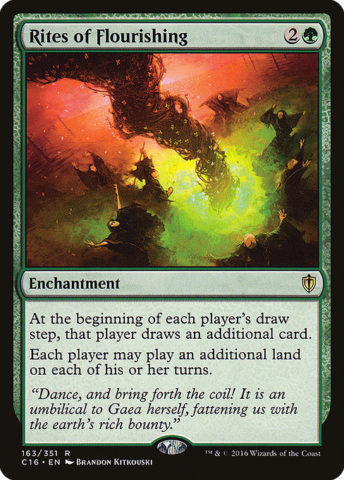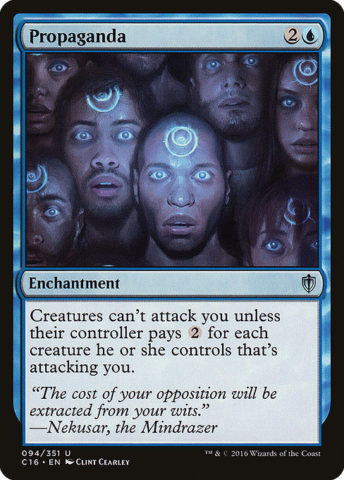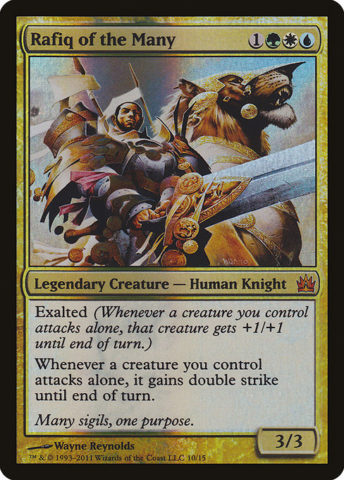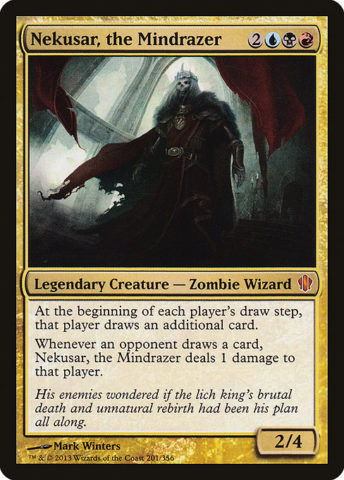This is perhaps one of the first deck explorations I have written for this site and it comes from years of tinkering and playing with a specific EDH strategy called Group Hug. To catch everyone else up, EDH is a format for Magic the Gathering where multiple people play with 100 card singleton deck at 40 life. The games are longer, the cards are crazier, and format has become a paragon for casual players as its regulations is dependent on social politics and in group rules. While the atmosphere of each EDH playgroup is different, the format tends to be more relaxed than the other competitive 60 cards formats while still offering high level strategies and play styles. The goal of the game is still similar to the rest of Magic where you are trying to win and make your opponents lose. This is where Group Hug deviates slightly as its main objective is to offer resources and advantages for everyone with things like card draw, more mana, and creatures casted without cost. One of the mascots for this style comes in way of a goofy looking hippo named Phelddagrif whose abilities give the controller advantages but at the cost of giving other players resources. Popular deck builds around this card are based not on winning by creating an advantage for oneself but by creating an edge based on being liked by other players. Think of Group Hug as instead of bringing weapons to a back alley brawl, one has a basket of cookies or perhaps more realistic, extra knives for others.
It is important to note that Group Hug is not a popular strategy. In fact, it is downright silly. Despite its innocuous nature, it remains either an obscure strategy or a maligned way of playing Magic. Recent commanders that employ the Group Hug strategy like Kynaios and Tiro of Meletis are half the philosophy of Group Hug and still half as popular as others with a more traditional gameplan. My interest in Group Hug comes from the social dynamics of EDH as a format and the ability to forge new paths with play. My Pheldagriff deck is perhaps one of my oldest and has thus gone through the interactions as I have developed new philosophies on how to play. While there are almost limitless cards to build decks around, Group Hug asks the question of “can you win with making everyone happy.” While I have not reached the point where I can definitively answer that question, my journey with this purple hippo has been on of self discovery and loud cackling. Below are my thoughts on the different style of Group Hug. While some people play differently, the philosophy of aiding opponents can fall into broad categories.

Group Hug as Kingmaker / Party Host
One of the classic ways to play Group Hug is to fill it with resource makers for other players. Extra cards, double mana, free creatures are all hallmarks to a traditional group hug deck. The philosophy is that everyone sitting down is having fun and the Group Hug player is here to put on music, pass out drinks, and go around and make sure people are having a good time. In theory this is a very simple and very appealing strategy for people to play. I began playing, quite simply, since I was not good at Magic and instead of trying to battle with skill and traditional war strategy, I made friends. This goofball strategy is a large trap as it appeals to people who want to be liked by a group and have a difficult time making lines of play which involve potentially making enemies. No one likes playing a game where they feel like they are on bottom climbing their way to the top so positing yourself as a neutral party and potential resource for other players can be attractive for players. This can also lead to the concept of Kingmaker or being the player who chooses the winner.
Traditional Pheldagriff decks, without a win condition will usually end in playing Kingmaker to the first player to utilize the resources given and able to formulate their own strategy to victory. While EDH has a large social aspect and is more relaxed than other formats, other players begin to dislike having to not only face off against their opponents but also a third party assisting their opponent. In theory, Group Hug helps everyone, the strongest decks becomes dominate and the person who was going to win without Group Hug wins quicker. My original Pheladgriff deck began as a Kingmaker deck in a very competitive environment and even though extra cards and mana make people feel good, strong combo decks are most certainly thanking you for your service before closing out the game. While I am not advocating how people play, there are stronger Group Hug philosophies which possess greater dimension that the Kingmaker style.
 Group Hug as Pillow Fort
Group Hug as Pillow Fort
Pillow Fort is the concept of making oneself either entirely neutral as not to be a threat but also unreachable. Once you do become a threat, however, you have build fortifications on your board as to not be messed with. Cards which dissuade opponents from attacking or changing your game plan are employed until the player can either combo into a win or use their board as a path to victory. The term “Pillow Fort” comes from the idea of softening damage while building up an army behind some imaginary barricade. The colors blue and white support the Pillow Fort strategy with Propaganda effects as well as the threat of destroying or removing creatures if they would do damage to the player. While I never made Pheldagriff a true pillow for commander, its strategy is as maligned as the group hug and perhaps as identifiable when playing.
The Pillow Fort player does not interact with the game and plays their lands and dampening fortifications. The attitude from the player is partially mischievous as they announce they are not doing anything which is a threat which usually means they are trying to be a threat just under the cover of darkness. Pillow Fort is a very easy strategy to ignore at the beginning of the game and becomes impossible to dismantle at the end. Good players will demolish the fort before becoming a problem as it is difficult to tell just when the Pillow Fortress will become too much a problem. It also leads to some awkward politics as one player could swoop down and destroy the fortifications while leaving the Pillow Commander upset and disbelieving. If one was going to play this style, I would suggest having thick skin as no one is going to allow you to build up this wall of enchantments without recourse.
 Group Hug as Bait & Switch
Group Hug as Bait & Switch
The Bait & Switch is similar to both Group Hug and Pillow Fort just with a more direct line of victory. This idea came to me after rebuilding Phedagriff as a enchantress build which supported controlling enchantments as control and slow advantage. When other players are relaxed enough, and before they can realize, the controller pulls the switch with power cards that buff up creatures, destroy lands, and erase boards allowing the one to walk across the finish line. With an enchantment style deck there are also big target cards like Enchanted Evening which allow a myriad of broken things to do resulting in a quick victory. This strategy only works with either people who have not played with you before or do not believe a lethal purple hippo is flaying through the air at them with cards like Ancestral Mask. The Bait and Switch style of play is similar to Pillow Fort where ones biggest obstacle is to act like they are not a threat until becoming strong enough to be a threat. It is more devious than Pillow Fort, more respectable than the Kingmaker style Group Hug and ultimately a glass cannon as it can not be pulled off with consistency with the same play group.
The original build for this Pheldagriff comes from the shell of Rafiq of the Many This is a Voltron style EDH deck where one creature is suited for lethal damage and runs roughshod all of the board. Rafiq however is on the most wanted list for commanders you never allow to resolve as it is really powerful and if given any sort of protection from disruption can one shot kill players without any response. A big stupid purple hippo is the same colors, same power and toughness and what it lacks in the doublestike aspect makes up for with the ability to fly and have trample. It is also 150% less threatening since people think you are going to be giving presents when you are really poisoning the wells.
 Group Slug
Group Slug
Group Slug is an archetype that is perhaps just as obscure as Group Hug. the concept is similar to Group Hug where the controller doles out gifts to everyone but the difference is those gifts are horrible. One other distinction is the possibility the controller is also in flames. Nekusar was also an early deck for me and is one of the most popular decks in the EDH REC database. Why? Well, it allows the mischievous strategy of making friends by drawing them cards but also has a chaotic path to victory as it causes life lose for anyone drawing cards. Endgame strategies for Nekusar include a ton of Wheel of Fortune effects or discard your hand and draw a new set of 7. With enough punishing effects each discard by players will result in 7, 14, 21 points of damage each Wheel.
Nekusar plays on the chaos side of EDH strategies. Unless crafted and played correctly, even the controller is at the whim of fate which fits into the red philosophy of play. Players enjoy drawing cards so getting an extra one at the cost of two life doesn’t seem that big of a deal until you are drawing 10 and losing 4 for each card. Nekuksar is a fun deck, has a clear line of victory, and is perhaps more respected that the traditional group hug or pillow fort style of play as it is trying to win while setting fire to everything around it.
 Group Hug as Diplomancy
Group Hug as Diplomancy
At the time of writing this article, I was attempting to build into this style of Group Hug. The idea is to play politics with voting, board balancing, and a maintaining of status quo while ensuring a fair game. This style of play is similar to a Fun Police deck where you nerf everyone else threats and make them play with gloves. Fun Police can quickly become an oppressive strategy overlapping into a very unfun style of play called Stax. This Fun Police lans more towards politics and social control with agreements and deals being struck around the table. While I love some of the new Battlebond cards which allow players to pay mana costs for counter spells and awarding people gifts for playing the game, the simple fact is the idea is dependent on other people playing your game. If a person decides to not award you the role of diplomat, you either have to snuff them out or deal with the ire of one person while allowing other players to gan advantage. It is a niche strategy which is not consistent with any playgroup. While my dream is to be an arbiter of fun, the simple fact is people will determine their own fun unless Wizards makes more cards that allow me to build into this strategy.
My Pheldagriff deck has gone through many changes and probally many more. Since I have a three color shell completewith lands and many staples, building new deviations in playstyle is simple. Recently, the new Core set allowed me to finally realize my dream of building a wall deck with the new Arcades Strategist dragon. While I have only played it a few times, the idea of playing walls that suddenly turn into cheap flying threats is something I have always wanted to do. Perhaps my dream of being a diplomat will be realized in the future but until then Ill play this 0/8 wall with flying and shroud for 3 and pass turn.
Tags: Hollywood Metal, Kaptain Carbon, Magic the GatheringCategorised in: Tabletop RPG

